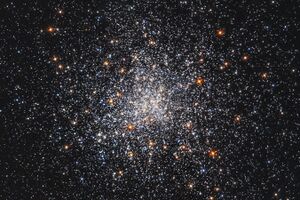Astronomy:Messier 79
| Messier 79 | |
|---|---|
 | |
| Observation data (J2000 epoch) | |
| Class | V[1] |
| Constellation | Lepus |
| Right ascension | 05h 24m 10.59s[2] |
| Declination | −24° 31′ 27.3″[2] |
| Distance | 12.9 kpc (42 kly)[3] |
| Apparent magnitude (V) | 7.7[4] |
| Apparent dimensions (V) | 8.7' |
| Physical characteristics | |
| Metallicity | [math]\displaystyle{ \begin{smallmatrix}\left[\ce{Fe}/\ce{H}\right]\end{smallmatrix} }[/math] = –1.55[5] dex |
| Estimated age | 11.7 Gyr[5] |
| Other designations | M79, NGC 1904, GCl 10, Melotte 34[2] |
Messier 79 (also known as M79 or NGC 1904) is a globular cluster in the southern constellation Lepus. It was discovered by Pierre Méchain in 1780 and is about 42,000 light-years away from Earth and 60,000 light years from the Galactic Center.
Like Messier 54 (the other extragalactic globular on Messier's list), it is believed to not be native to the Milky Way galaxy at all, but instead to the putative Canis Major Dwarf Galaxy, which is currently experiencing a very close encounter with our galaxy. This is, however, a contentious subject as astronomers are still debating the nature of the Canis Major dwarf galaxy itself.[6] Messier 79 may also be part of the Gaia Sausage.[7]
The cluster is being disrupted by the galactic tide, trailing a long tidal tail.[8]
Color-magnitude diagram
This color-magnitude diagram was made using near-infrared images of the cluster in J and K bands. J-band magnitude is plotted along the y-axis and J to K dominant color is plotted along the x-axis. Such a diagram is made rapidly with specialized code for crowded-field photometry.[9]
From this, it is evident that most of the bright stars in this cluster are red giants. The elongated branch is the red giant branch. Some of the stars in the diagram, including those extending outward from the red giant branch toward the upper left, are actually foreground stars that are not members of the cluster.
Altogether three regions of the Hertzsprung–Russell diagram are present here: the low-mass end of the main sequence, the complete red giant branch and the horizontal branch. Compared to optical bands, in infrared bands the lower main sequence is shallower and the horizontal branch is steeper (the blue end is fainter and the red end is brighter).
See also
References
- ↑ Shapley, Harlow; Sawyer, Helen B. (August 1927), "A Classification of Globular Clusters", Harvard College Observatory Bulletin 849 (849): 11–14, Bibcode: 1927BHarO.849...11S
- ↑ 2.0 2.1 2.2 "M 79". SIMBAD. Centre de données astronomiques de Strasbourg. http://simbad.u-strasbg.fr/simbad/sim-basic?Ident=M+79.
- ↑ Harris, William E. (December 2010), A New Catalog of Globular Clusters in the Milky Way, Bibcode: 2010arXiv1012.3224H, http://physwww.mcmaster.ca/~harris/mwgc.dat
- ↑ "Messier 79". https://messier.seds.org/m/m079.html.
- ↑ 5.0 5.1 Koleva, M. et al. (April 2008), "Spectroscopic ages and metallicities of stellar populations: validation of full spectrum fitting", Monthly Notices of the Royal Astronomical Society 385 (4): 1998–2010, doi:10.1111/j.1365-2966.2008.12908.x, Bibcode: 2008MNRAS.385.1998K
- ↑ López-Corredoira, M.; Momany, Y.; Zaggia, S.; Cabrera-Lavers, A. (2007). "Re-affirming the connection between the Galactic stellar warp and the Canis Major over-density". Astronomy & Astrophysics 472 (3): l47. doi:10.1051/0004-6361:20077813. Bibcode: 2007A&A...472L..47L.
- ↑ Myeong, G.C.; Evans, N.W.; Belokurov, V.; Sanders, J.L.; Koposov, S. (2018). "The Sausage globular clusters". The Astrophysical Journal 863 (2): L28. doi:10.3847/2041-8213/aad7f7. Bibcode: 2018ApJ...863L..28M.
- ↑
- ↑ This diagram was made by Astromundus students attending lectures and a workshop by Peter Stetson, the writer of DAOPHOT, standard code for crowded-field photometry. Date: June 2011, University of Rome Tor Vergata
External links
- Messier 79, SEDS Messier pages
- Messier 79, Galactic Globular Clusters Database page
- Messier 79 on WikiSky: DSS2, SDSS, GALEX, IRAS, Hydrogen α, X-Ray, Astrophoto, Sky Map, Articles and images
Coordinates: ![]() 05h 24m 10.59s, −24° 31′ 27.3″
05h 24m 10.59s, −24° 31′ 27.3″
 |



